Volume 25 Issue 2 | March 30, 2022
This newsletter and the advice herein are free. You usually get what you pay for.
Crop Weather
Rainfall, air and soil temperatures, degree-days, soil moistures, and other current and historical weather data for the University of Minnesota Southwest Research and Outreach Center (SWROC), a little spot about two miles west of Lamberton, MN, can be found at http://swroc.cfans.umn.edu/weather. As of Monday, there was still frost down to 39” and the weekend cold snap had produce more frost close to the surface
Enlist Duo is now OK in MN
See yesterday’s EPA release on how and why here: https://www.epa.gov/pesticides/epa-expands-use-enlist-products-134-additional-counties-2022-growing-season
Can you manage your way out of corn rootworm problems?
Part 1: Tool selection
Corn rootworm management was one of the crop pest problems I puzzled over this past winter. Recently, some warm weather got me thinking about changing the oil and blade on my year-old lawnmower. It’s a replacement for an old machine that suffered from a lack of Zen during my maintenance efforts. Most repair efforts involved a couple of screwdrivers and pliers ‒ the only tools I could count on finding on the garage bench. Multi-purpose, they did duty as crude hammers and pry bars in a pinch. The sets of socket and box end wrenches, including those special metric jobs, and multiple sizes of screw bits, reside safely in the tool chest back at the house, but those precision tools don’t get much use. The few tools on the bench could usually be made to work, and who has the time to walk back from the yard to get the right-sized wrench. The old mower had bolt heads where an active imagination could still find six sides and there were broad valleys that no longer resembled an opening for a screwdriver bit. Overuse of a few simple tools had gradually rendered some parts nonfunctional. Those parts damaged by poor tool choices needed replacement, but other issues sent the old mower down the road. I was convinced that more attention to detail would provide long-term benefits whilst wrenching on my new mower.
Most of you are better mechanics than I am and use pliers and screwdrivers only for the tasks they were engineered for but, what does my lawnmower have to do with corn rootworms anyhow? Like my mower’s rounded bolt heads and stripped screw slots, there are quite a few fields of corn in SW Minnesota (and elsewhere), where prolonged, imprecise use of simple, effective management tools such as crop rotation and Bt means they might not have the grip on corn rootworms that they once did.
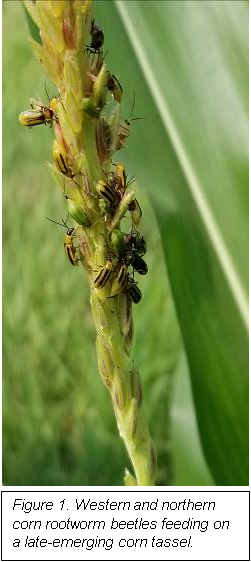
Part 2: How we got where to where we are and where are we heading?
Transgenic corn hybrids with Bt traits resistance to corn rootworm larvae (Bt RW) have been planted in Minnesota farm fields since 2003. Previous experience with the Bt traits for European corn borer and some dramatic early Bt RW performance in sites heavily infested with corn rootworms encouraged a rapid and widespread adoption of the technology, often without regard to the level of risk from rootworms. Here was a tool that was more effective, easy to use, and relatively economical compared to insecticides. The inclusion of Bt RW traits in high-yielding hybrids meant it could work in fields with a 1/4-inch, 3/8-inch, 12-mm, or whatever level of risk from corn rootworm. Bt RW hybrids quickly replaced at-plant insecticides as the primary corn rootworm management tool on many farms.
Before Bt RW tools were available, crop rotation was a simple and very effective tool for managing corn rootworms ─ and for the most part, it still is. Corn rootworm larvae feed on the roots of grasses and cannot develop on the roots of broadleaf plants. Rootworm beetles lay their eggs in the soil of cornfields, their preferred host. Although rootworm larvae feeding and survival have been observed on some prairie and weedy grasses, nearly all of these appear to be lesser hosts than corn. Hypothetically, small larvae might be able to feed on the roots of grass weeds such as foxtails and barnyard grass with larger, less susceptible larvae moving to Bt corn. Weedy, volunteer corn plants can allow larvae to survive within a soybean field and late-pollinating volunteers may attract egg-laying females.
Within Minnesota, the western corn rootworm (WCR) has been an economic pest problem in fields of continuous corn, and rotation to a crop other than corn crop has been highly effective. In eastern corn belt landscapes dominated by a corn-soybean rotation, a behavioral variant of WCR arose. This variant, not yet identified in Minnesota, will lay its eggs outside of cornfields. Unlike the eggs laid in cornfields, likely to hatch in corn and starve, the rotation adapted variant eggs laid in soybean fields are likely to hatch in a suitable corn host.
The northern corn rootworm (NCR) has historically been the most common Minnesota species, particularly in the more northerly rootworm infestations. For many years, they too could be managed when corn was rotated with a nonhost crop.
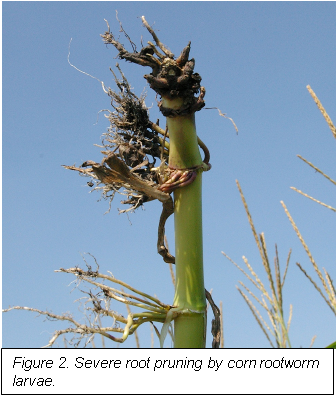
The eggs of both WCR and NCR diapause (suspend development) during the winter. Over time, adapting to the predictable, corn-soybean rotation that was prevalent on many Minnesota farms, the proportion of an extended diapause biotype increased within NCR populations. Extended diapause biotype larvae find themselves in a suitable corn host because egg hatch is delayed through an extra winter (occasionally even longer). However, not all NCR individuals have extended diapause genetics and both biotypes do well in continuous corn. During the mid-1980s and again in the early 2000s ‒ coincidently, just before the first Bt RW hybrids were released ‒ extended diapause caused significant problems in parts of southern Minnesota. Growers were encouraged to employ insecticide and subsequently, the new Bt RW traits on rotated acres. Bt selection pressure in both rotated and continuous fields was now widespread.
Not unexpectedly, in 2009, I saw my first SW Minnesota fields of continuous Yieldgard® rootworm (Cry 3Bb1 Bt RW protein toxin) with unexpected injury from WCR. The lodged plants, pruned roots, and clouds of rootworm beetles were big hints that the same tool had been used too often. By 2012, some fields planted to continuous Bt RW hybrids saw poor control from multiple Bt RW traits, including a pyramid of two Bt RW traits. Complicating management, cross-resistance to three forms of Cry3 protein (Cry 3Bb1, mCry3A, eCry3.1Ab ) has been documented in WCR. One or more of these proteins are present in all Bt RW pyramids. Pyramids of two Bt RW proteins were intended to slow the development of resistance. Unfortunately, Cry3 cross-resistance and increasing resistance to Cry 34/35AB1, often paired with a Cry3 protein, has created some very uncooperative rootworm populations.
Along with overall lower NCR populations, Bt resistance issues in NCR have lagged those in WCR. The northerns are on the board now too with resistance confirmed in some 2018 North Dakota fields. See The Handy Bt Trait Table (2022) for more details on Bt traits.
In many fields, WCR and NCR populations ‒and depending on the hybrids planted, resistance to individual and pyramided Bt RW traits ‒ have been increasing for several years. However, developing corn rootworm problems are masked during years of low rootworm populations with minimal root injury and lodging.
WCR populations in southwest Minnesota were relatively low for a few years, presumably due to egg mortality during the bitterly cold winter of 2013-14. The survival of newly hatched larva can be reduced by excessively wet early-June soils. WCR populations had rebounded in long-term corn research plots at the UM SWROC by 2019, and by 2021 large WCR populations and Bt resistance became widespread in southern MN continuous corn. Populations of NCR in Minnesota had been depressed since the mid-2000s but they, and associated extended diapause, are also on the rise.
Although less effective than a Bt RW pyramid on a susceptible rootworm population or rotating out of corn, at-plant insecticides remain a useful option for rootworm management. Adult corn rootworms resistant to some foliar insecticides (e.g., chlorinated hydrocarbons, organophosphates, pyrethroids) and larval resistance to at-plant insecticides (e.g., chlorinated hydrocarbons) have been documented in some areas of the corn belt. However, currently labeled at-plant insecticides protect a limited portion of the corn root system and are persistent and effective only for a limited time. In effect, the part of the root system without insecticide can act as a built-in refuge. As a result, at-plant soil insecticide resistance in rootworm larval populations has been less of a concern than with Bt or foliar insecticide applications. Research at the SWROC and other MN locations indicates that at-plant insecticide options vary in efficacy. In general, granular insecticides are the most consistent, liquids are more variable, and rootworm rates of seed-applied insecticides are least effective. At-plant insecticides can reduce root injury, but they do not reverse Bt or rotation resistance and often do not reduce populations of beetles emerging from the field.
Both rootworm species tend to become more abundant in a field with increasing years in corn. Areas of Minnesota with a large percentage of continuous corn fields tend to be where overall rootworm populations are highest and unexpected injury to Bt RW hybrids occurs most often. Rotation from corn is the best option in these cases, particularly where Bt-resistance is suspected. Rotation will eliminate WCR in the field and reduce non-diapause NCR populations in the field, but will it not affect an area’s overall level of Bt resistance. Therefore, high overall rootworm beetle populations in the area can quickly reinfest a field with Bt-resistant rootworms. Previously, Bt resistance problems were most often found in fields that had been planted to corn for several years but in 2021, I’ve heard reports of WCR causing unexpected injury to 2nd-year corn.
Adding an at-plant insecticide to Bt-RW hybrid in a field where Bt resistance is suspected is like using vice grip pliers to turn a bolt with a rounded head. Even though you might accomplish the task, you probably have made the underlying problem worse.
Use rootworm management that fits the field. New technology was designed to prevent ham-fisted operators from destroying the heads of bolts and screws. Sure, those Allen and Torx head screws minimize damage from my efforts, but I’ve managed to wreck those too. New RNAi technology (e.g., SmartStax Pro) to control corn rootworm larvae is becoming available. Yes, it is effective and offers another rootworm management tool. However, because it kills more slowly than insecticide or Bt, the RNAi trait is stacked with a Bt RW pyramid. It's possible for yield-limiting rootworm injury to the roots of these new hybrids if they are planted in a field with high populations of Bt-resistant rootworms. I can fit a small flat-bit screwdriver into a Torx or Allen head, but the results have been disappointing every time I’ve tried it.
One-size-fits-all approaches seldom live up to lofty expectations. They may have worked acceptably back in the day of square-headed bolts, but underemployed hex-head bolt salesman surely encouraged the use of those darn adjustable crescent wrenches. While many agriculturalists seem intent on trying, the rootworms keep telling us that there is still no one-size-fits-all, long-term corn rootworm management strategy.
Part 3: Developing a management plan.
Early corn planting and dry springs tend to favor the survival of corn rootworm larvae. Those same conditions tend to reduce the effectiveness of at-plant insecticides. Rootworms do have some weak points. NCR eggs are relatively cold-tolerant but prolonged cold, open winters can cause mortality to WCR eggs wintering in the soil. Larval mortality can occur if soils are saturated when small larvae are trying to enter corn roots. By late July and August, you will know how successful both corn rootworms and your corn rootworm management strategies were.
For several years, Dr. Ken Ostlie and I have been examining methods to monitor rootworm populations using yellow sticky traps and a network of farmer, industry, and Extension cooperators. The cooperators receive traps and management information for the fields they monitor, and pooled cooperator data is starting to provide ground truth observations on WCR and NCR interactions with crop rotation and Bt. Several seed companies have contributed their trap data to the project in the past and participation is welcome again in 2022. This work is supported, in part by the farm families of Minnesota and their corn checkoff investment. If you would like to participate in this project during the 2022 growing season let me know!
Cooperators tend to place most traps in fields where they suspect rootworm populations are high‒ a logical approach from a management standpoint. As a result, these data likely overestimate overall populations. Nonetheless, based on examining trapping results from over 200 fields, some expected and some disturbing information on Minnesota corn rootworms started to surface during the high rootworm populations of 2021 (Table 1).
- Rootworm populations and the proportion of WCR to NCR increase with the number of years of corn with NCR tending to dominate in northern locations.
- There are fields of 1st-year corn with large NCR populations ‒presumably extended diapause (Figure 3).
- Large numbers of WCR beetles were captured in a few 1st-year cornfields. Concerning, was the in-field beetle emergence observed in one case. hese were in areas with large overall WCR populations but whether this was due to egg-laying in the previous year’s soybean crop, or another reason has not yet been determined (Figure 3).
- NCR beetle captures tend to be lower in fields with Bt RW but unfortunately, there are exceptions. However, there is little to no difference in WCR between fields with and without Bt RW (Figure 4).
Individual fields vary in rootworm species composition, rootworm population density, and Bt RW resistance. Adjacent fields may have completely different rootworm populations and risks for injury. In other words, there is a mosaic of rootworm populations and genetics within a field and across the landscape. Each field is unique because of hybrid, planting date, and other cropping history factors.
How can you determine the risk of corn rootworm injury to corn roots in a field? It requires a considerable labor investment in the jungle-like conditions of tasseled corn during August, but scouting is the only way to select the best rootworm management tool for a field.
Corn rootworm beetles are mobile. Beetle populations and their offspring are usually variable within a field. Apart from those rootworm disaster fields where the result of poor rootworm management is reminiscent of the Hindenburg, looking at just a few plants or yellow sticky traps in a field will not provide a good estimate of beetle populations. Developing a sound scouting plan for counting beetles on plants or yellow sticky traps can help determine the risk for future corn injury within the field. Combining your beetle scouting with observations on lodging and root injury can help you get a handle on whether the beetles emerged within the field and potentially indicate resistance to Bt RW.
Mostly through trial and error, I figured out there was more than one size bolt on the old mower. It is risky to select a rootworm management tool based on scouting results from a different field. On the other hand, scouting information from numerous fields might provide an estimate of overall populations and their changes from year to year. Scouting corn rootworms provides details.
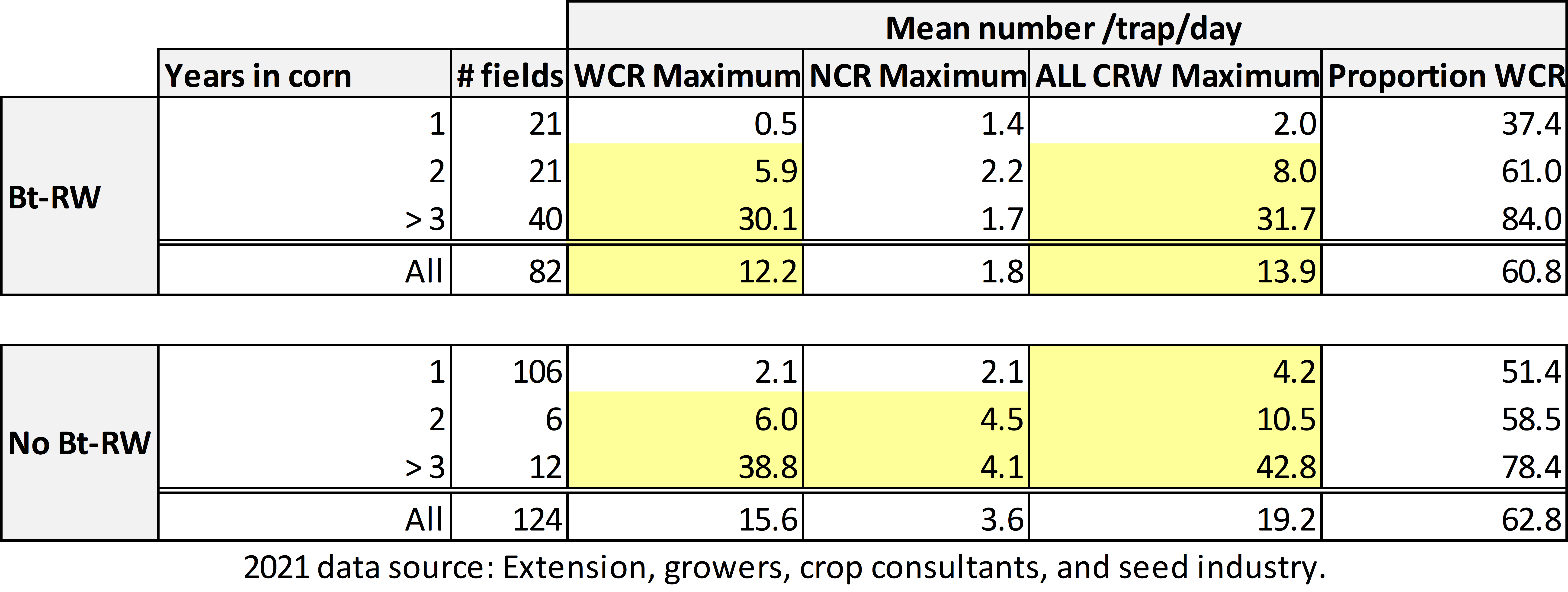
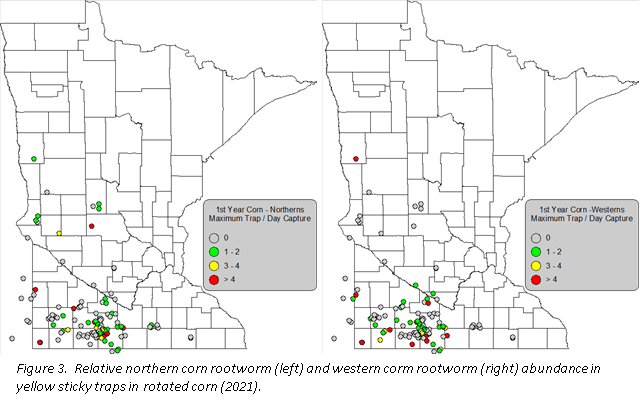
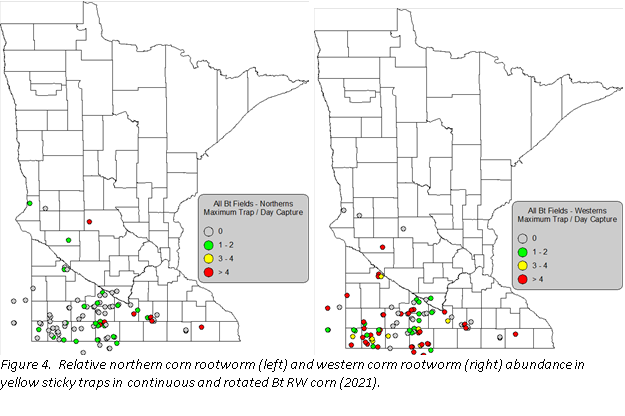
Part 4: It’s complicated. Some points to consider when developing a rootworm management plan of your own.
- There are no good options to rescue a field from rootworm injury after planting.
- Eventually, a management program is likely to fail when you use the same management tool over and over.
- Corn rootworm problems are field-specific. Use beetle scouting and/or sticky traps to determine the risk for each field.
- Use root injury scores and beetle populations to evaluate your RW management success and adjust as necessary each year.
- Root injury is often more yield-limiting, and insecticides perform less well, under drought stress. You do not need to use a control tactic on low rootworm populations. Bt-RW hybrids and insecticide applications to low rootworm populations will not provide an economic benefit but they still select resistant individuals. (The management philosophy for rootworms should be different from weeds; besides, you can’t kill them all…really).
- A Bt RW trait or full rate of an effective at-plant insecticide can provide ROI when the previous year’s scouting indicates a risk of lodging and/or yield loss from rootworm feeding.
- Add a full rate effective insecticide layer to a Bt RW hybrid when populations are high and/or you are planting a Bt RW hybrid and suspect resistance. Large, Bt-resistant populations are often found in areas where continuous corn production is prevalent. As rootworm pressure increases, you might benefit from planting hybrids with larger root systems.
- Rotate out of corn where very high RW populations occur. Traits and/or insecticides may not provide adequate control of very high populations, particularly in fields with some level of Bt resistance to Bt RW is suspected. Beetle control to control silk clipping may sometimes be needed to allow pollination but economic benefits from these treatments are not common.
So… you have lots of beetles and unexpected injury to a Bt RW hybrid (more than ½ node of roots pruned to within 1 ½ inches) and you can’t or won’t rotate the field out of corn?
- Contact your seed dealer to report the performance failure. They will document the damage and perhaps more importantly check for Bt expression. I know it’s hard to believe but, sometimes a field gets planted to the wrong hybrid.
- Rotate the field out of corn! Seriously! Other management options risk unacceptable root injury and continued resistance development. You can plant a hybrid without a Bt RW trait and apply a full rate of an effective at-plant insecticide. Depending on the insecticide, rootworm population density, and the weather, the insecticide may/or may not provide adequate control. Remember, even with the insecticide applied, the field can still produce large numbers of Bt-resistant beetles to colonize neighboring fields.
- Bt RW hybrids share traits across companies and there is cross-resistance to some traits. Very high levels of resistance to Herculex® and associated Cry3 traits mean the Bt hybrids will probably perform like a hybrid without Bt. You are encouraging the development of even higher levels of resistance to Bt even with an insecticide overlay.
- Beetle control may reduce egg-laying in the field to a manageable level, but intensive, prolonged scouting is needed to properly time the multiple foliar applications that are typically needed.
- New rootworm management technologies are being introduced (i.e., RNAi) or still under development in top-secret locations. However, history and rootworm biology tell us that these too will likely be overcome eventually. The RNAi technology needs an effective Bt RW trait companion to perform well. Placing these new hybrids into fields with very high rootworm populations and Bt RW resistance is asking for trouble. Rotating the field out of corn for at least a year would be the best tool to use.
My new mower still has all its bolt and screw heads intact and judicious use of the proper tools at the proper time should

keep things functioning well ‒ It seems that the bolt holding the blade to the crankshaft might need some special treatment though ‒ A piece of pipe over the wrench handle and a hammer ought to do the trick.
Happy trails,
Bruce Potter
